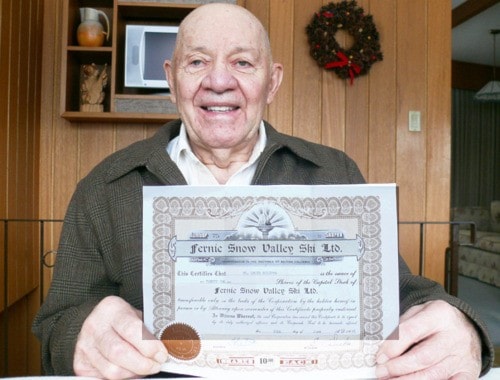It was Fernie’s decision to make a bid for the 1968 Winter Olympics that secured its future as a ski des- tination.
In 1960 the Chamber of Commerce launched a campaign to bring the Games to the new Snow Valley ski area in the Lizard Range where Fernie Alpine Resort is now situ- ated.
Other towns bidding for the Games were Rossland, Banff, Manning Park and Garibaldi Park – which later became Whistler.
Both Fernie and Canada were unsuccessful with their bids – the Canadian Olympic Committee backed Banff but the International Olympic Committee eventual- ly gave the Games to Grenoble, France.
However the Fernie committee, which was part of the Chamber of Commerce, was undeterred.
“Much benefit should come from the publicity received during the Olympic campaign and in the near future we may see a development on our ski site that could mean a much-needed secondary industry in this area,” said chairman of the local committee Telfer Dicks, a gar-age owner, in 1961. The Olympic committee was dissolved and immediately reappointed as a ski development committee.
Acting on the committee were Telfer Dicks, garage owner; Jack Crabb, geologist, Don Bacon, elec- trical engineer and James Ryley, local government agent.
By November 1961 the Snow Valley Ski Development Ltd had been set up as a private company with authority to sell $125,000 worth of shares at a par value of $100 per share.
Until 1962 Louis Sclippa was an underground miner with Crows Nest Industries, who owned the mines at Coal Creek near Fernie.
When he asked to change his work, his bosses made him gen- eral manager of the new ski hill they were helping to set up for the enjoyment of their employees.
His first job was to cut the road from the highway up to the ski base area, which he remembers as taking several days.
That summer the chalet was built and the first tow bar lift was installed – a 4,500 ft lift running from the bottom station of the modern-day Deer Chair up to the Bear ’s Den where the Elk Chair now ends. The Free Press in Dec. 1962 had high praise for the lift and slopes it serviced.
“In the words of a mechanical inspector who has viewed many, the lift is ‘one of the best in the country.’”
“A meandering woodland trail beginning near the top lift terminal offers a trail-runner ’s delight and leads right back to the lower terminal.
“For those with further zest for exploring wooded runs, the access road or adjacent power line offer a variety of choice.”
After the ski hill opened, Sclippa became the go-to man for any kind of lift or building maintenance.
He also loaded skiers at the bot- tom of the tow lift and took their tickets. There was just him and one other helper working on the hill at any time so there was nobody at the top of the tow lift to help skiers unload.
Sclippa, who is now 85 and still lives in Fernie, says he remembers the old fixed “bear trap” ski bind- ings causing many accidents on the tow lift.
“One Sunday we had 17 broken legs. The worst times for accidents were when we kept the lift open for half an hour or an hour longer on a good day – people were tired and that’s when they hurt themselves.
“There were so many injuries the City found an old ambulance and sta- tioned it up at the ski hill all weekend.”
Back then, grooming was carried out by a ski- doo pulling a tube with aluminium spikes on it. Grooming was done every new snowfall.
There was a volunteer ski patrol team, but when skiers were injured they were loaded onto the back of a skidoo and brought down the mountain – often by Louis.
Despite spending a dec- ade working the ski hill, Louis never tried skiing – in fact, he still thinks skiers are “crazy.”
“I never had time to ski – anyway, I had no time - the lift would break down or the pop machine would need filling, or someone would get stuck in the car park and need a tow,” he said.
Meanwhile the ski hill was still run by the vol- unteer board of directors, with community members supporting the local hill through buying shares.
Rick Yerburgh, who also still lives in Fernie, was a director from 1965 and later became president for two years.
He remembers getting involved after his father-in- law answered to one of the ski hill’s “cash calls”, when they sold shares to local supporters. Shareholders got half-price skiing, but his father-in-law was not a skier, so he asked for his
sons-in-law to be given the shares instead.
Yerburgh said the com- pany broke even most years, and he could remem- ber the excitement when they hit the grand total of 300 skiers in one day.
He remembers: “It was good skiing. It wasn’t that big an area but it had hard- er points and easier points to suit everyone.
“We always thought it would expand eventually, but nobody every realized itwouldbeasbigasitis now.”
A second tow lift was later put in to the top of the Bear run. A rope tow from the Griz Inn chalet also ran to the top of begin- ners slopes where Kelsey’s restaurant now is.
In 1972, the majority interest in the Fernie Snow Valley was acquired by Heiko Socher who increased the lift access further up the mountain before selling it to Charlie Locke, who also owned Lake Louise Ski Resort, in the 1990s.
Snow Valley Ski Hill became Fernie Alpine Resort in 1998 after it was bought by Resorts of the Canadian Rockies, who developed the “new side” with the Timber Chair Lift and White Pass Lift and the Great Bear lift.
